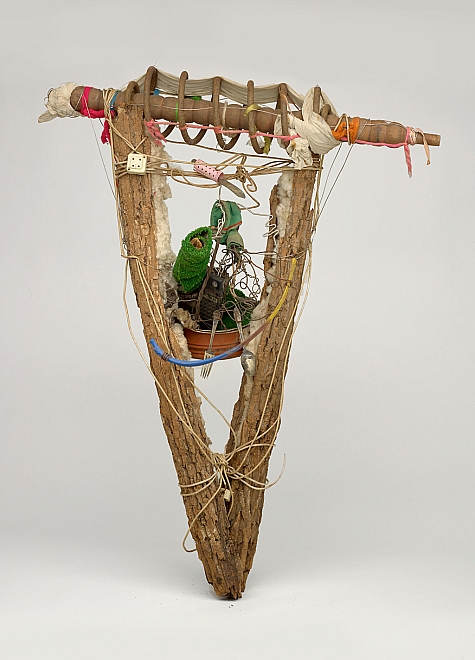Fourth of July Pot
When Lonnie Holley speaks about his sculpture, he doesn't begin with the piece itself, but with the feelings and events that led up to it, making his act of creation seem almost inevitable. "How much one day could take away from our way of living," he says, telling the story of an assemblage he made called Fourth of July Pot,
“if a person don't understand that day. A lot of us that can't read or write don't even know what independence mean. They just celebrate because they know that the day is a day to celebrate yearly. We as a people can easily get involved in traditions and ceremonies, and join in and become actors in those things. That's good in a way—in a way it's not. We still have to control our habits. The Fourth of July Pot shows we're out of control as far as some of those habits is concerned. Sometimes making preparation for a celebration we spend too far and too much.
It's the old way versus the new way: the old way was celebrated after the harvest from the seeds that we planted. Today we're taking from that harvest without all of us being interested in replanting.“
Having established the moral text of his story, Holley then goes on to show how the components of this particular work of art touch on points within his narrative. The Fourth of July Pot was made shortly after Independence Day in 1991. At first glance, it appears to be a rough and random gathering of found materials with little more than the barest structure to organize it, to distinguish it from clutter, but Holley's piece tells of a specific event in which he saw serious implications for himself and his own community. One of his neighbors (a mother on welfare) had chosen to spend her government check throwing a barbecue for all her friends rather than saving it to feed her hungry children. In Fourth of July Pot, her family appears silhouetted in wire among various mementos of the misguided feast: eating utensils, the pot, a brightly painted pork rib. A VCR remote control, gaudy carpet, and tattered clothes hint at the inconsistencies in their way of life; a steel spring wedged between the two halves of tree bark reinforces the splitting effect her negligence is having on her children.
"The two pieces of wood," he says,
“the tall bark and the short bark, man and woman, show the value of the old, and the cotton they had picked and harvested around the Fourth of July. The bark shows the strength of the outside, because we had lost the value of the inside. The cotton is in place of the true tree to show their labor was true at that time.
It is tied up to hold itself in place because of communication. If we had listened as well as watched for the value of the truth of the whole tree, we would have been stronger; and it would have allowed us to fill our pot, not just on the Fourth of July, but every day after that. Our habits allowed us to take advantage of the pot and the meat, all the way to the bone. The meat gave us very little strength, leaving us blue because of high blood pressure and other sickness it could cause.
All the value we put into that day become tied up in many ways from the bed we slept in, and it causes a strain, and tension, of trying to keep enough money for the habits of one day's celebration.”
It is unlikely that, without Holley's spoken (and now recorded) explanation, a mainstream-oriented viewer could correctly interpret Fourth ofJuly Pot. As a physical object, it exists as a half-text to be completed only by the words (the story) that must accompany it and flesh it out. However, his approach is hardly surprising to anyone steeped in southern (and particularly southern African American) traditions, who might find Holley's approach intimately familiar; in it, such a person could recognize affinities between the combined aesthetic and educational functions of his sculpture as well as with the structure (and—when he speaks—the format) of both Sunday-morning sermons and all the social-setting stories told on front porches and in beauty parlors, pool halls, and barbershops throughout the South.
Drupal Theme and Development By: Cheeky Monkey Media
Site Design By: Constructive
